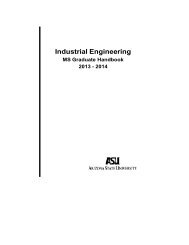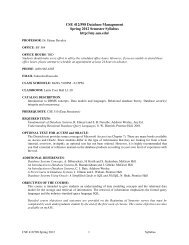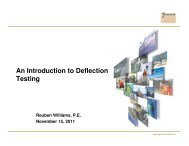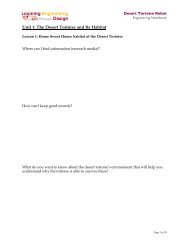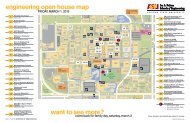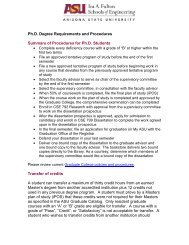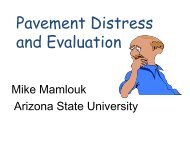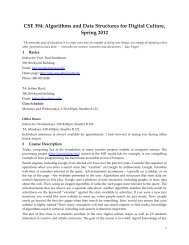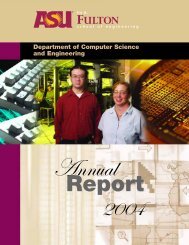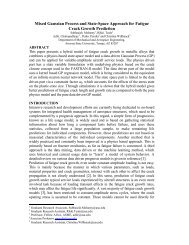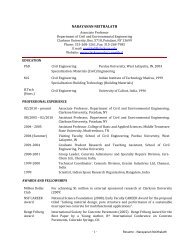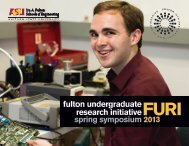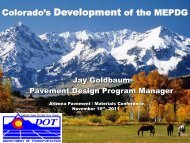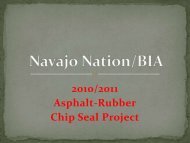Abstract Book - Ira A. Fulton Schools of Engineering - Arizona State ...
Abstract Book - Ira A. Fulton Schools of Engineering - Arizona State ...
Abstract Book - Ira A. Fulton Schools of Engineering - Arizona State ...
Create successful ePaper yourself
Turn your PDF publications into a flip-book with our unique Google optimized e-Paper software.
Undergraduate Research<br />
Oceanic Microbial Cell Separation: Utilizing the Principles <strong>of</strong> Pinched Flow<br />
Fractionation to Create a Bacteria Cell Separating Micr<strong>of</strong>luidics<br />
Raisa Ahmad, Bioengineering<br />
Graduation: May 2011 Hometown: Chandler, <strong>Arizona</strong><br />
Mentor: Dr. Weiwen Zhang, Civil and Environmental <strong>Engineering</strong><br />
Grand Challenge: Engineer the tools <strong>of</strong> scientific discovery<br />
The specific goal <strong>of</strong> this honors research project is to create a micr<strong>of</strong>luidic device that is able to concentrate<br />
oceanic biological samples, isolate bacteria, and then use these samples for further metagenomic analysis. The<br />
primary aim <strong>of</strong> the research will model the flow behavior <strong>of</strong> mixed microbes through the process <strong>of</strong> pinched<br />
flow fractionation—a process that utilizes continuous size separation <strong>of</strong> particles using a laminar flow pr<strong>of</strong>ile in a<br />
pinched microchannel. The device will be tested to determine if particle separation and classification is possible<br />
in a passive and low-energy system that is sustainable in isolated deep-sea ocean environments.<br />
<strong>Engineering</strong> Optimization <strong>of</strong> Cyanobacteria Growth for Sustainable Bi<strong>of</strong>uels<br />
Cody Alan Anderson, Environmental <strong>Engineering</strong><br />
Graduation: May 2011 Hometown: Thermal, California<br />
Mentor: Dr. Raveender Vannela, Biodesign Institute<br />
Grand Challenge: Energy and sustainability<br />
The overall purpose <strong>of</strong> the research is to optimize cyanobacteria growth for use in bi<strong>of</strong>uels. We are using a highlycontrolled<br />
photobioreactor to compare the effects <strong>of</strong> pulse lighting on the growth rate, chlorophyll concentration,<br />
and other qualities <strong>of</strong> the cyanobacteria. Early results indicate that the pulse lighting does have a positive effect<br />
as compared to steady lighting. Further research will go into determining the effects <strong>of</strong> various parameters <strong>of</strong><br />
the system, such as pulse frequency, on/<strong>of</strong>f duration, light intensity, cell density, and so forth.<br />
Sensor Design for Measuring Ventilation in Use with an Adaptive Neural<br />
Stimulator and Spinal Cord Injuries<br />
Chad David Andresen, Bioengineering<br />
Graduation: May 2010 Hometown: Peoria, <strong>Arizona</strong><br />
Mentor: Dr. Ranu Jung, Bioengineering<br />
Grand Challenge: Biological and human systems; Engineer the tools <strong>of</strong> scientific discovery<br />
The objective <strong>of</strong> the project was to determine an appropriate sensor to measure the respiratory flow <strong>of</strong> a rat. Over<br />
the past semester, research has been performed on two sensors that characterize diaphragm performance. The<br />
sonomicrometry sensor is an invasive technique that uses sonar to measure the contraction <strong>of</strong> the diaphragm.<br />
The pneumotachometer is semi-invasive and measures the respiratory flow <strong>of</strong> a rat. The findings <strong>of</strong> the project<br />
and journal-based research determined that a rat-modified pneumotachometer would be the optimal sensor.<br />
Future work would be to use the sensor in conjunction with the adaptive controller for use in humans with spinal<br />
cord injuries.<br />
Spring 2010 7



